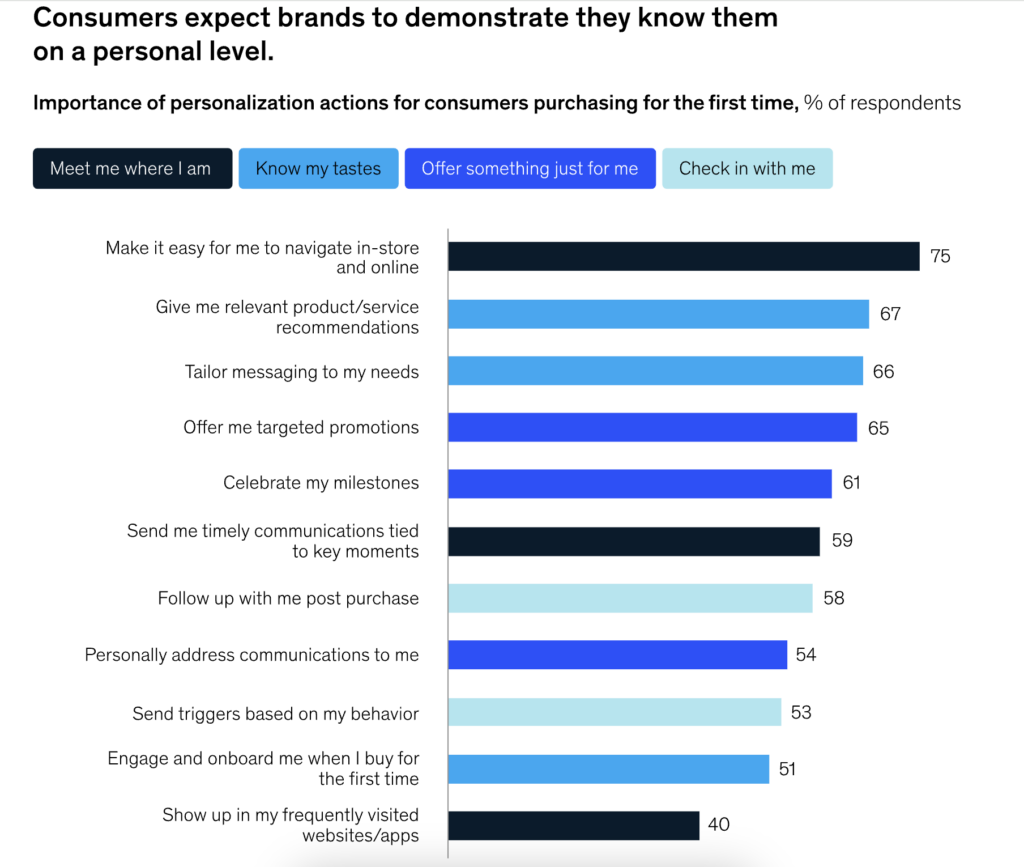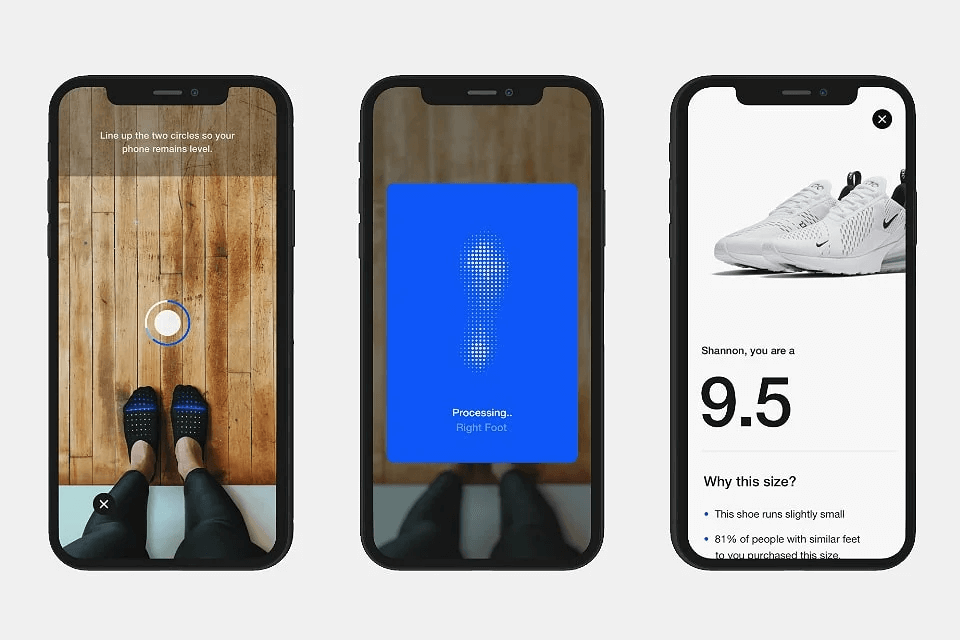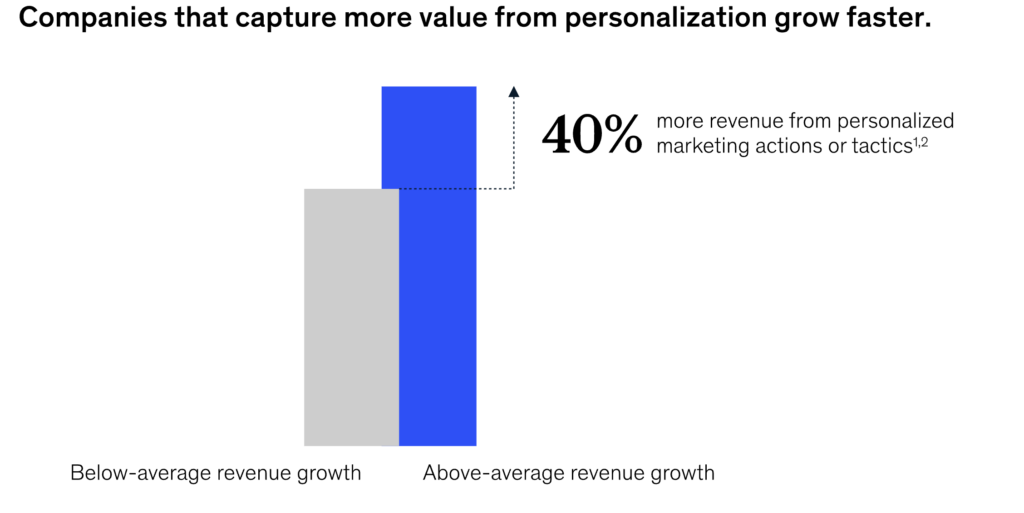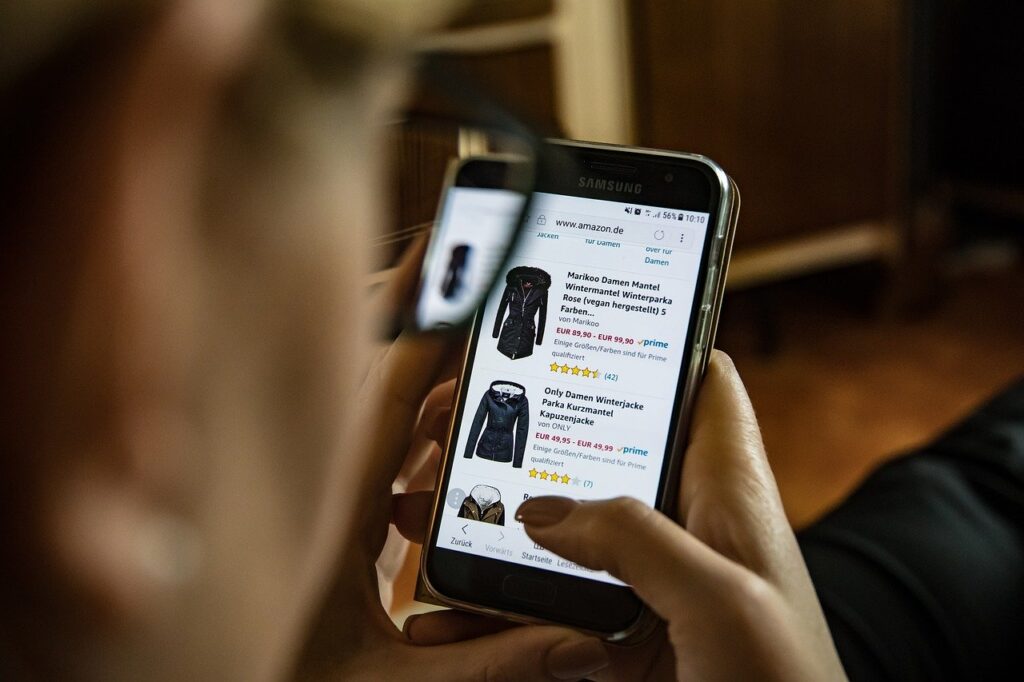Personalization has steadily become a defining factor in the field of digital marketing, allowing brands to strengthen customer engagement and build long-lasting loyalty. Generic approaches are no longer accepted by consumers as marketing strategies evolve. Therefore, marketing agencies like Multiplayer and gamified.marketing are trying to provide a more interactive and personalized approach to connect with customers. In fact, Accenture reports that 91 percent of customers are more likely to shop with brands that know customer preferences and provide personalized offers. The change in consumer expectations led to a change in marketing approaches and artificial intelligence helps enable these changes.
There are several areas where artificial intelligence is currently involved in marketing, namely customer segmentation, data analysis, content personalization, and real time customer interactions. With generally larger sets of data, AI tools can predict behaviors, understand preferences and can deliver highly targeted experiences instantly. McKinsey reports that companies who use AI personalization have an increase in sales by 20% or more. The role of AI in getting companies to communicate with their audiences becomes central.
While the journey to highly personalized marketing experiences has been gradual, it started with success of loyalty programs, and email campaigns. These first ideas segmented audiences by basic data such as purchase history or demographics, which were the groundwork for the upcoming improvements. They weren’t providing customers with an individual approach and personalized experience. But by automating the personalization process, AI has completely changed this and allowed businesses to get to the next level in terms of relevance in their marketing efforts.
Due to the AI’s ability to process and analyze massive amounts of data, machine learning and predictive analytics have made it possible for brands to overcome traditional segmentation. With AI, brands don’t categorize customers by general traits such as demographics or age, but instead analyze their specific actions and preferences in real time. In industries like retail and e-commerce such a personalized approach is crucial. We can see it in the examples of Amazon and Netflix that are approaching marketing in more scalable and personalized ways, transforming the way brands interact with customers.
For example, Amazon’s recommendation system that monitors customer behavior brings in 35% of the company’s total revenue, showing how AI impacts personalized customer engagement.
In addition, personalization isn’t limited to product suggestions. It helps facilitate dynamic interactions, from the first visit on a website to subsequent post-purchase communications. With each interaction, AI systems learn from how customers behave and refine their predictions making future interactions more relevant, strengthening customer relationships, and boosting lifetime value.
The results are compelling as AI advances and is being more and more integrated into marketing. Businesses who use AI for personalized marketing have seen a 15% increase in profits, and AI-driven email campaigns have 41% higher click through rates with 29% higher conversion rates than the non-personalized ones. These figures demonstrate how impactful AI can be on some of the biggest metrics associated with marketing: customer engagement and conversion.
Types of AI-Driven Personalization
On a large scale, AI-driven personalization has changed the game for brands interacting with customers by providing personalized content, recommendations and personal interaction. Each of these strategies relies on different AI models, which offer different ways to talk to the customers.

Image Source
a) Predictive Personalization
Predictive personalization uses predictive analytics to anticipate customer needs, actions, or behaviors before they occur. Using past data to predict future behavior helps brands create highly relevant content, product suggestions, marketing messages, and more. Predictive personalization has already shown its potential in reducing customer churn, improving product recommendations, and boosting sales.
Reducing Customer Churn
Predictive models are particularly effective when it is necessary to identify the customers who are about to leave a platform or stop engaging with a brand. For example, Netflix uses predictive analytics to track viewing habits and behavior as well as engagement patterns in order to flag subscribers at risk of canceling their service. With AI powered personalized recommendations, Netflix reduced customer churn by 5%, saving $1 billion in annual customer subscription revenue.
The predictive analytics are also used by such companies as Vodafone and AT&T in the telecom sector to detect at-risk customers. The analytics is based on usage trends, payment behaviors and interactions of the customers with customer service. Studies show that businesses that apply these strategies can cut churn rates by up to as much as 40%.
Improving Product Recommendations
Predictive analytics in the retail industry allows businesses to analyze customers’ past behavior and use the data to predict what products they are interested in and/or inclined to buy. Amazon, for example, uses predictive models to analyze the history of purchase and the browsing behavior of its customers and then generates personalized product recommendations. As a result, it makes a significant contribution to Amazon’s revenue — 35 percent of Amazon’s sales are comprised by these AI powered suggestions.
Walmart also incorporates predictive personalization by analyzing customer purchasing and online browsing habits to offer personalized product suggestions and targeted promotions. The quality data on customers’ preferences helped increase both online and in-store purchases.
Boosting Sales Across Industries
The use of predictive personalization has been shown to significantly increase sales in all sectors. A McKinsey study found that companies that use predictive analytics in their marketing observe a 10 percent to 15 percent rise in sales. Predictive models benefit from such industries as retail, e-commerce, financial services and even healthcare since these tools help businesses to offer more personalized services, improving customer engagement, and conversions.
Predictive personalization is also useful in the travel and financial services sectors. In travel, platforms like Expedia use predictive models to recommend flights, hotels, and activities based on user behavior, while financial institutions use predictive analytics to offer personalized investment advice or loan products based on a customer’s financial profile.
b) Dynamic Personalization
Dynamic personalization refers to real-time personalization that adapts to the user’s actions, preferences, and interactions with an advertisement. This type of personalization is especially effective in digital marketing channels because content, offers, and recommendations there can be instantly adjusted to match user behavior and preferences.
Dynamic Personalization in Digital Channels
Dynamic personalization can be effectively used in digital marketing as it allows a brand to edit website content, email campaigns, and advertisements in real time. Spotify is one of the examples of how effective real-time personalization can be. Spotify offers personalized playlists, song recommendations and user interface which are updated in real time based on listening habits of users. Spotify, with over 433 million users, shows how customer-centric AI can help increase revenue, engagement and user experience with AI-driven personalization.
Dynamic personalization can also be done on social media platforms such as Facebook and Instagram through targeted ads. They use their AI systems to customize ads to customers’ preferences based on how a user interacted with it: whether there is like, share, or comment. When using dynamic personalization, brands can optimize their marketing budget, increase the quality of targeting and improve the overall performance of a marketing campaign.
c) AI-powered Recommendations
Recommendation engines that are powered by AI are very important for personalized marketing because they provide suggestions of products, content or services based on users past behavior and preferences. These systems rely on three types of recommendation techniques: collaborative filtering, content based filtering, and hybrid models.
Collaborative Filtering
Recommendations by collaborative filtering is a popular method which provides suggestions based on user item interactions. It takes into account user’s preferences and then predicts what a user would enjoy based on the likes of other similar users. Netflix and YouTube have been first adopters for collaborative filtering. This technique is used by Netflix’s recommendation engine and it generates 80% of all the content watched on the platform.
Content-Based Filtering
Content-based filtering suggests content that is similar to the things a user has already interacted with or liked. For example, Spotify’s recommendation engine suggests songs based on the characteristics of tracks a user has previously enjoyed. By analyzing features such as genre, tempo and mood, Spotify provides highly personalized song recommendations. It allows the platform to keep users interested for a longer time and increases the level of engagement with the platform’s content.
Hybrid Models
A hybrid recommendation system combines the best of collaborative and content-based filtering to improve accuracy and effectiveness of advertisements. One example of a hybrid model is Amazon’s recommendation engine, that combines user behavior (through collaborative filtering) with product attributes (via content-based filtering) to suggest items. Part of Amazon’s success is claimed to be due to this approach, as 35% of Amazon’s total revenue came from its recommendation engine.
In the same way, YouTube uses a hybrid recommendation system, which combines collaborative filtering to provide users with videos based on user interaction and content based filtering using video metadata availability. Taking into account the number of videos on youtube and amount of overall content, such an approach is crucial for keeping users on the platform. This also prevents users from being lost on the platform, presenting them content that suits what they want to see.
Impact of AI Technologies on Marketing
AI technologies have significantly influenced the results of marketing campaigns. Businesses are now able to give an integrated view of their customers and offer personalized experiences in many channels by combining machine learning, natural language processing (NLP), deep learning and predictive analytics.
AI in Action: Personalization Case Studies Transforming Industries
By delivering more relevant and engaging customer interactions through AI driven personalization, industries throughout the world have quickly been transformed. Sectors from retail, banking to hospitality have turned to AI using the latest technologies in NLP, machine learning, and predictive analytics to adjust to new customer needs.
Retail: Hyper-Personalization with AI

Image Source
Nike. Nike uses AI to enhance personalization at every step of the customer journey. Nike sends personalized product recommendations through its mobile app using individual’s preferences, information about previous purchases, and browsing history. Nike Fit, the brand’s AI-powered feature helps customers find the perfect shoe size by analyzing foot scans and matching them with the most suitable products.. As a result, Nike’s digital platforms have seen a 40% increase in conversion rates due to this level of personalization enabled by AI-powered recommendations.

Image Source
What Nike does with personalization is not just product suggestions. Nike also uses customer data across many touchpoints to deliver more personalized workout plans, exclusive offers, and content all geared towards each user’s unique fitness goals. This holistic personalization strategy has heightened the relationship that brand has with its consumers, resulting in greater loyalty and lifetime engagement.
____________________________________
Sephora. AI has enabled Sephora to recreate a personal shopping experience by analyzing customer data to provide personalized product recommendations. Through its Virtual Artist feature, Sephora allows users to try on makeup virtually using AI and augmented reality. This way of interacting with customers directly on the platform can break a ‘display-wall’ between a customer and virtual shop. This online AI-driven personalization strategy by Sephora has helped to increase conversions both online and in-store.
The positive customer response to personalized experiences in the retail industry demonstrated the effectiveness of this approach. Personalization has become widespread: 63% of customers expect personalization as a standard element of their online shopping experience, and about 49% of consumers have made impulse purchases after receiving personalized product recommendations. To achieve such high results, the input of artificial intelligence is crucial. It helps collect data about customer preferences quickly and effectively, analyze it and turn into effective solutions.
Banking: Personalized Financial Services with AI
JPMorgan Chase. JPMorgan Chase has transformed its customer experience by using AI to provide personalized financial services. The bank’s COiN (Contract Intelligence) AI system helps analyze legal documents and customer transactions to provide tailored investment advice and identify personalized banking solutions for clients. With AI, JPMorgan Chase can make highly relevant product recommendations, personalized loan offers and investment strategies by analyzing customer behavior, spending habits and financial goals.
Bank of America. In banking, AI-powered chatbots are an additional tool that provides more personalized experience by improving customer support. For example, with virtual assistants such as Erica, the Bank of America provides customers with financial insights, spending summaries and even payment reminders based on account activity.
In 2023, clients interacted 673 million times with Erica, the most widely available virtual financial assistant. This was a 28% increase year-over-year. This brings the total interactions since launch to nearly 1.9 billion.
With the advancement of an AI-driven banking personalization, 50% of banking customers now expect their bank to provide customized product recommendations. Additionally, nearly 40% of customers are more likely to switch banks if their financial institution doesn’t offer relevant, personalized services.
Hospitality: Enhancing Guest Experiences with AI
Hilton. Hilton has deployed AI-driven personalization through its Connected Room initiative that allows guests to control such room features like temperature, lighting and entertainment systems using mobile devices.

Image Source
Hilton can then use AI to collect and analyze guest preferences, and customize room settings for each individual guest for a much more holistic and positive guest experience.
How application of AI affected customer preferences across industries?
As AI continues to improve personalized experiences in various industries, customer preferences are changing as well. Customers are now expecting more personalized interactions and in some cases are even ready to share their data in exchange for a better, more relevant experience.
Studies have shown that over 83% of consumers are willing to share their data, to provide more personalized experiences. However, trust and transparency are a point that should be taken seriously, because 48% of consumers are worried that companies will use their personal data in ways they didn’t agree to. To address these concerns, businesses must focus on ensuring data privacy and security while delivering personalized content.
Furthermore, the Segment report showed that 60% of consumers believe that they will become repeat buyers after a positive, personalized shopping experience. That is a big change from past years, when only 44 percent of consumers shared the same sentiment. With AI coming of age, consumers expect greater and greater levels of personalization, and those businesses that are unable to deliver this risk losing customers.
AI in personalized marketing has revolutionized the customer experience across all industries. Businesses can analyze customer data and apply advanced algorithms to deliver relevant, timely and personalized interactions that will lead to customer satisfaction, loyalty and revenue. With the customer’s preferences changing due to the use of AI-powered personalization, businesses must adapt and also invest in innovative AI technology for providing them with an improved customer experience.
Impact on Conversion Rates and Customer Engagement
AI has proven yet again that it can greatly increase conversion rates, customer engagement, and profitability with AI powered personalization across various industries. AI-driven marketing helps companies build stronger relationships with their customers and as a result increase sales, loyalty and long term customer value. It delivers tailored experiences to meet the needs of every individual customer and their needs.
Impact on Conversion Rates and Profitability
The positive effects of AI-powered personalization on conversion rates and business profitability have been demonstrated in numerous studies. For example, a report by McKinsey found that organizations implementing personalization strategies driven by AI have seen an increase in conversion rates of 10% to 30%. The reason brands can achieve more customer engagement and drive more sales with AI is due to its ability to analyze huge datasets and produce real time, personalized recommendations.
In the ecommerce sector, one of the most impressive examples is Amazon with 35 percent of total revenue driven by its AI-powered recommendation engine.

Image Source
Amazon does this by suggesting relevant products to the customers based on their purchase behavior. It basically helps them sell more, driving better conversion rates and higher average order value.
There is also a lot of success seen with AI-driven personalized email marketing campaigns. In fact, Campaign Monitor found that personalized emails powered by AI drove 41% higher click-through rates and 29% higher conversion rates than non-personal ones. This allows AI to segment audiences, and therefore deliver targeted, engaging content, which leads to better performance.
In financial services, AI-driven personalization has been shown to increase conversion rates for customized loan products, credit offers, and investment recommendations. JPMorgan Chase uses AI to analyze customer data and provide personalized financial advice and is predicted to boost the sector’s profits by $170 billion in just four years.
Industries with the Highest Improvements in Conversion Rates
Different levels of success have been achieved by AI-driven personalization in different industries. Ecommerce, Retail and Financial Services are sectors where conversion rates and customer lifetime value are seeing the most improvement.
1. E-Commerce and Retail
AI-powered personalization has seen enormous benefits for e-commerce and retail. Using AI, brands like Sephora and Nike use AI to quickly create very personalized product recommendations to customers, which increases customer satisfaction and conversion rates. Customer engagement is no exception, and according to Katrina Wong, VP of marketing at Twilio Segment, “consumer demands for personalization continue to skyrocket, and businesses see a massive opportunity for AI to help them meet those demands.”
The report also found that a personalized experience would result in 56% of consumers becoming repeat buyers, showcasing a 7% increase from the previous year’s study.
2. Financial Services
In the finance industry for example, AI is helping to offer personalized investment recommendations. The traditional advisory services can group clients into general risk categories and usually employ broad strategies. Moreover, AI-powered platforms give a more sophisticated understanding of how individual behaviors and preferences function. Analyzing data like spending patterns, income, and financial goals, these platforms give personalized investment suggestions that become more client-centered based on how the user interacts with them — they adapt to changing client financial needs.
AI is also contributing to the area of customized financial planning. Financial planning involves developing ways of managing income, investments and expenses to achieve desired long-term financial objectives. Financial plans are created by AI technology by analyzing a person’s financial data such as earnings, spending, debts, and investments to have a comprehensive financial plan based on a person’s financial needs.
3. Travel and Hospitality
AI is a fast growing trend for the travel and hospitality industries which help in providing more personalized experience to the customers. To predict customer preferences, Expedia and Marriott International for example, use AI to suggest customized vacation packages, hotel amenities, and travel itinerary based on individual needs.
This is where some of the world’s largest hotel brands are pouring significant investments. Choice Hotels International has integrated AI into their mobile app to provide personalized travel recommendations and itineraries for their guests. IHG Hotels & Resorts is getting in on the act and recently announced the upcoming launch of a generative AI-powered travel planning capability that can help guests easily plan their next vacation directly in the IHG One Rewards mobile app. Expedia Group, via their experimental EG Labs, has launched Project Explorer, a trip planning tool powered by OpenAI.
Personalization’s Impact on Customer Segments
The impact of AI-driven personalization varies from one customer group to another, as there are different preferences that can be affected by age, lifestyle and the level of technological adoption. It ıs considered that Gen Z responds best to personalized marketing and interacts with brands that provide personalized content and products.
1. Gen Z
Gen Z, born between 1997 and 2012, places a high value on personalized experiences, especially in digital spaces. 74% of Gen Zers are interested in personalized products compared to 67% Millennials, 61% Gen Xers and 57% Baby Boomers. Social media platforms such as Instagram and TikTok also influence Gen Z with personalized ads and recommendations, leading to higher conversion rates from these channels.
2. Millennials
Millennials, who grew up during the rise of digital marketing, are similarly responsive to personalized interactions. 70% of millennials are willing to let retailers track their browsing and shopping behaviors in exchange for a better shopping experience. AI-driven personalization in e-commerce and financial services has had a significant impact on conversion rates and long term brand loyalty for this demographic.
3. Baby Boomers
Baby Boomers (born between 1946 and 1964) are not in the habit of digital personalization as their younger siblings, but they do find tailored financial and healthcare services useful and preferable. For example, personalized investment recommendations from AI-powered robo-advisors have seen increased engagement among Boomers, as they appreciate services that help them manage retirement planning and financial goals.
Personalization’s Role in Customer Journey Mapping and Marketing Funnel Optimization
AI driven personalization is key to mapping the customer journey and optimizing marketing funnels. AI enables marketers to deliver personalized content aligned to each stage of the customer’s journey by analyzing interactions across touchpoints — such as websites, mobile apps, social media and email.
AI can help improve a marketing funnel offering tailored experiences at every stage to increase engagement. For example, personalized email campaigns to customers with abandoned carts have been proven to increase conversion rates. On top of that, AI models can also predict when a user is most likely to churn and trigger retention focused content or offers, resulting in increased customer retention overall.
What’s more, AI-driven analytics are able to deliver insights on where customers fall out of the funnel. It makes brand personalization strategies more realistic and results in higher conversion and more efficient marketing.
Conclusion
By delivering highly relevant experiences that take into account individual needs, AI-driven personalization is a new level of connecting brands with consumers. Companies can use technologies like machine learning, natural language processing (NLP) and predictive analytics to analyze customer behavior, recommend products and deliver personalized content in real time. Such an approach has significantly increased engagement and conversion rates across e-commerce, retail, finance and hospitality sectors. AI-powered personalized marketing has been proven to increase conversion rates for such brands as Amazon, Netflix, Nike and others up to 30%.
In addition, AI helps to optimize marketing funnels by creating a more personalized customer journey on every step of contact with a brand, from initial discovery to the final purchase. AI-driven personalization can help businesses get a competitive advantage and improve overall customer loyalty.
